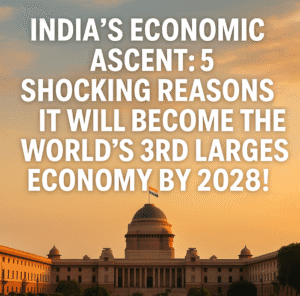India’s Economic Ascent: 5 Shocking Reasons It Will Become the World’s 3rd Largest Economy by 2028!
By 2025, India is set to overtake Japan and Germany, securing its position as the world’s fourth-largest economy with a nominal GDP of $4.18 trillion, according to IMF projections. This milestone reflects a decade of rapid growth, driven by a tech-driven digital revolution, manufacturing reforms, and a youthful workforce. By 2028, India is expected to claim the third spot ($5.58 trillion), trailing only the U.S. ($30.5 trillion) and China ($19.2 trillion).
While the U.S. and China remain unmatched in scale, India’s rise highlights shifting global dynamics, fueled by strategic policies and demographic advantages. Challenges like job creation and inequality persist, but India’s ascent signals a transformative phase in the global economy, with Asia poised to dominate future growth. The 2025 rankings underscore a multipolar world where emerging giants reshape trade and geopolitics.

India’s Economic Ascent: 5 Shocking Reasons It Will Become the World’s 3rd Largest Economy by 2028!
The global economic landscape is undergoing a dramatic transformation, with India emerging as a powerhouse set to reshape the hierarchy of the world’s largest economies. According to the International Monetary Fund (IMF), India is projected to leapfrog Germany and Japan by 2028, securing its position as the third-largest economy. Here’s a detailed, insightful breakdown of the IMF’s 2025 projections and what they mean for the global order.
Understanding Nominal GDP
Nominal GDP measures a nation’s economic output at current market prices, without adjusting for inflation or cost of living. While it reflects overall economic size, it doesn’t account for purchasing power parity (PPP), where India already ranks third. The IMF’s 2025 rankings highlight shifts in raw economic clout, driven by growth rates, demographics, and policy reforms.
2025 Global Economic Rankings: Key Highlights
- United States ($30.5 Trillion)
The U.S. retains its top spot, fueled by innovation, a robust services sector, and energy production. Its GDP is projected to be 7.3 times larger than India’s in 2025, underscoring its unmatched scale.
- China ($19.2 Trillion)
China’s growth, though slowing, remains formidable. Its GDP is expected to be 4.6 times India’s, with challenges like an aging population and real estate debt tempering momentum.
- Germany ($4.74 Trillion)
Europe’s largest economy faces headwinds from energy transitions and manufacturing reliance, yet maintains its third position in 2025.
- India ($4.18 Trillion)
India edges past Japan by a razor-thin margin ($4.18T vs. $4.18T) to claim fourth place in 2025—a symbolic milestone in its ascent.
- Japan ($4.18 Trillion)
Japan’s stagnant population and deflationary pressures contribute to its slide, though advanced technology and exports keep it competitive.
- United Kingdom ($3.83 Trillion)
Post-Brexit reforms and a strong financial sector anchor the UK’s sixth-place standing.
- France ($3.21 Trillion)
France leverages aerospace, tourism, and EU integration to maintain steady growth.
- Italy ($2.42 Trillion)
Despite debt challenges, Italy’s manufacturing and agriculture sectors drive its eighth-place rank.
- Canada ($2.22 Trillion)
Natural resources and immigration fuel Canada’s resilient economy.
- Brazil ($2.12 Trillion)
Brazil rounds out the top 10, buoyed by commodities and a growing tech ecosystem.
India’s Growth Trajectory: From 5th to 3rd
- 2025: India surpasses Japan to become 4th largest (GDP: $4.18T).
- 2026: Overtakes Germany to secure 4th place ($4.6T).
- 2028: Projected to clinch 3rd position ($5.58T), trailing only the U.S. and China.
Drivers of India’s Rise:
- Demographic Dividend: A youthful population (median age 28) fuels labor force growth.
- Digital Revolution: Tech-driven sectors (e.g., UPI payments, IT services) contribute 8% to GDP.
- Policy Reforms: Production-linked incentives (PLIs) boost manufacturing; infrastructure investments hit $1.4T (2019–2023).
- Global Trust: “China+1” strategies position India as a manufacturing alternative.
Challenges Ahead:
- Job creation to match workforce expansion.
- Bridging urban-rural inequality.
- Managing climate transition costs.
The U.S. and China: Titans in a League of Their Own
While India’s rise is notable, the U.S. and China remain in a separate tier. By 2025:
- The U.S. economy will be larger than the next four (China, Germany, India, Japan) combined.
- China’s GDP, though slowing, still grows by ~$5T annually—equivalent to adding an economy the size of Turkey each year.
Beyond 2025: A Multipolar Economic World
The IMF’s projections signal a shift toward Asia, with India and China accounting for 35% of global GDP growth by 2028. However, developed economies like the U.S. and Germany will continue dominating per capita income metrics, highlighting disparities in wealth distribution.
Conclusion
India’s economic rise reflects strategic reforms and demographic potential, but sustaining growth requires addressing structural challenges. As the U.S. and China vie for supremacy, India’s journey to becoming a $5.5T economy by 2028 will redefine trade, diplomacy, and global supply chains. For now, the 2025 rankings offer a snapshot of a world in flux—one where traditional powers hold ground, while emerging giants carve their legacy.
You must be logged in to post a comment.